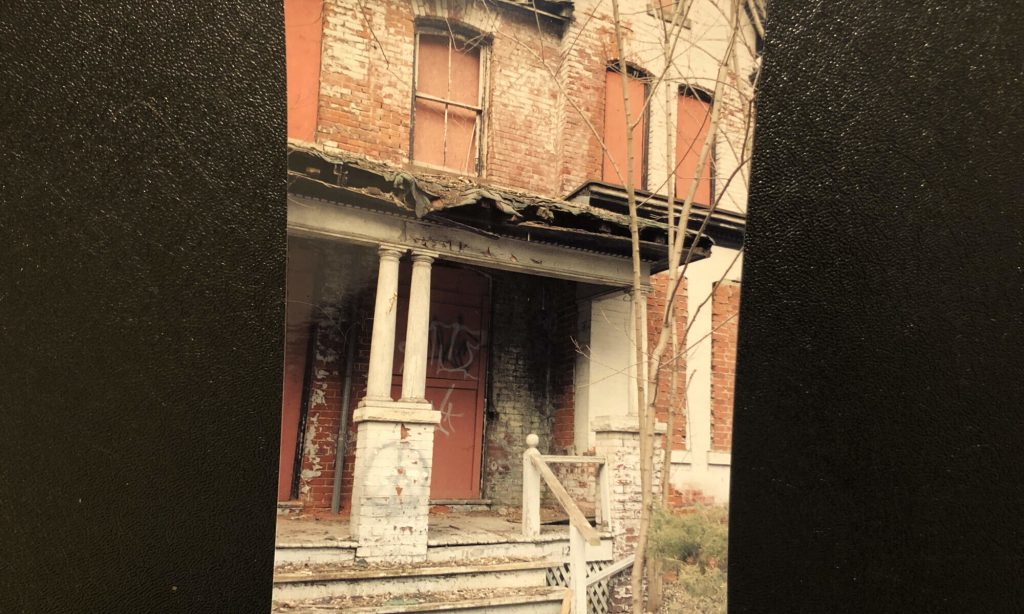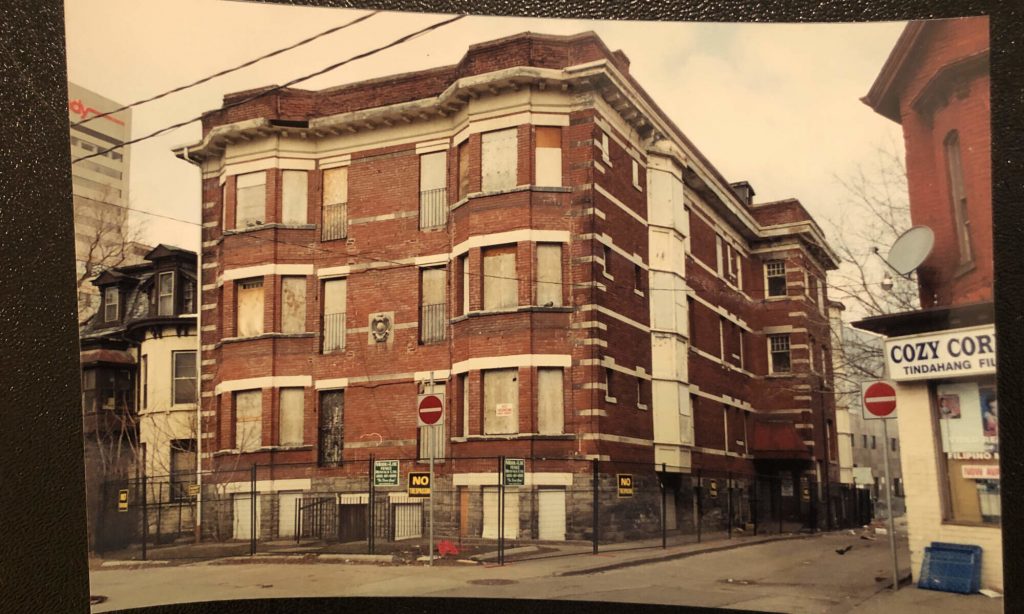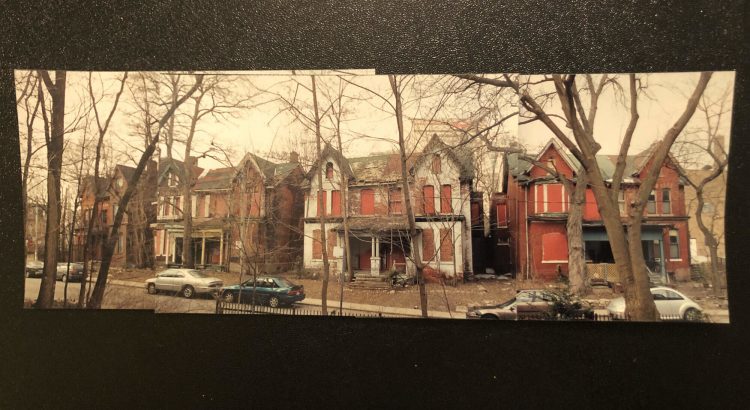Globe: Safe as Houses? Maybe Next Year (Glen Road Houses)
Oct 7, 2006
From the Globe, Toronto Section:
Safe as houses? Maybe next year
For residents of Glen Road, new city rules to save heritage buildings can’t come soon enough
ALEX BOZIKOVIC
Glen Road starts at St. James Town and goes downhill from there. From the famously troubled apartment complex at its south end, the short street runs straight until it meets a concrete overpass that bears Bloor Street’s traffic. At night, things get rough. “It’s only hookers and drug dealers,” says Vera Salmon, who lives above her laundromat nearby. “Due to these buildings, all kinds of crackheads are bringing down the neighbourhood.”
The twist is that Ms. Salmon isn’t talking about the violence-plagued towers of St. James Town; instead, she’s complaining about the row of six Victorian houses at the end of Glen Road. Five are boarded up, their gabled facades eroding, one with a large hole in the roof. During her eight years on nearby Howard Street, Ms. Salmon has seen these properties, and the immediate area, deteriorate dramatically. She was a police sergeant in her native Guyana, and “the little things don’t frighten me,” she says. But she’s seen prostitutes working Glen Road by daylight — “I’m ashamed to tell you, I saw an older gentleman and a woman doing their business at 3:30!”
To neighbours like Ms. Salmon, the vacant buildings are possibly in danger of collapse. And that is exactly how the owners want them, they say. The beleaguered buildings are heritage properties that can’t be torn down — unless, of course, they’re ruled unsafe, and the city’s Building Division has them demolished.
To Councillor Pam McConnell, what’s happening to the houses is a clear case of a growing problem that the city hopes to soon address: “demolition by neglect.” In other words, the buildings are deteriorating, which could result in them being demolished. “I think that when you leave holes in the roof open . . . then absolutely you’re neglecting the property,” she says.

In downtown Toronto, this has occurred a few times in recent years. Earlier this year, three Victorian houses on Sherbourne Street were knocked down by the city. And on Shuter Street, a row of Georgian townhouses has local Councillor Kyle Rae concerned; partly because of their poor state, he called last summer for a new bylaw that will force owners of heritage properties to maintain the heritage attributes of their buildings, or face fines. This is a new level of protection for aging buildings, and it will force owners to repair damage that’s already done — and give the city the power to step in and do the work if they don’t. The new bylaw, based on the City of Miami’s tough preservation laws, is expected to be approved by City Council after the election. (The current council supported it without debate, subject to the details being worked out by staff.)
“It isn’t that we haven’t done anything,” Ms. McConnell says of the Glen Road properties. The city’s Municipal Licensing and Standards division did a sweep of the area earlier this year, and issued a number of work orders on the houses, but the owners appealed them all to a city oversight body — and, when the orders were upheld, appealed them again to Ontario Superior Court, which will hear the case next year. And enforcing the basic upkeep of buildings was all the city could do until last year, when changes to the Ontario Heritage Act granted municipal officials more power to take proactive steps.

For Gabriel Resch, that can’t come soon enough. As a tenant and the property manager of a multi-unit house on Glen Road, he lives next door to the crumbling Victorians, and he’s frustrated with the city’s response so far. “I feel the city has abandoned this neighbourhood,” he says. “We’re in a no-man’s-land here, between Rosedale — the most desirable residential neighbourhood in the city — and St. James Town — one of the least. And nobody wants to act.”
From the roof of his building, he sees what city building inspectors can’t: debris scattered across the roofs of the Victorians. There are large piles of lumber, along with assorted garbage: bricks, a propane tank, spilled paint, smashed clay pots. A small tree is growing on one roof, and at 8 Glen Rd., debris is spilling into a hole that spans the entire building. As Mr. Resch points it out, a hefty raccoon ambles out of the hole and wanders along the roofline.
The houses’ property manager, Moti Sawh of Excel Property Management, says his mandate is to keep them in good repair “at all times.”
“We’ve spent like $400,000 there just to clean them up and make them weather-tight,” he says.
When told about the hole in the roof, the debris — and the tree growing there — he said he wasn’t aware of the situation. “If that’s the case, I’ll clean it up. We did some work in the summer there and cleaned up everything. But sometimes trees grow so fast, you know?”

But Mr. Resch believes the lack of repairs is part of a pattern in the neighbourhood. He cites the case of 6 Howard St., just around the corner — Toronto’s most dramatic recent example of demolition by neglect, and another case Mr. Rae cited in calling for the bylaw. In February, he took pictures of the historic apartment building’s roof from a tower nearby. The images show piles of bricks arranged near one of the building’s chimneys, while a long piece of lumber is sticking out of a hole in the roof. A month later, the roof of 6 Howard collapsed; the low-income tenants in a house next door were evacuated, eventually giving up their homes. And the city stepped in to raze the damaged building in the name of public safety. The end result: a vacant lot, and a vacant house next door whose yard is visibly a haven for drug use.
What happened this year on Howard Street was alarmingly familiar to Ms. McConnell, who likens it to the systematic “blockbusting” of the 1960s and ’70s, when developers emptied nearby streets of their Victorian housing stock to make way for the towers of St. James Town. On Howard Street, she says, “I think the tactic was to blockbust. That’s what it smells like to me. That’s what it feels like to me. And those are old tactics.”
Particularly interesting to Ms. McConnell is the fact that the Glen Road houses and 6 Howard have the same property manager, Excel Property Management. It’s difficult to determine exactly who controls the properties, but four of the six houses are co-owned by Grossman Holdings Ltd., Bleeman Holdings Ltd., and J. Silver Holdings Ltd, developers who have also owned St. James Town properties.
Ms. McConnell says her staff has approached lawyers and representatives for the Howard Street and Glen Road properties to talk about developing the sites. “The community is more than happy to discuss the plans. But we have not received anything back. So I’m not certain that . . . there is any plan,” she said.
Now, she’s asked the city-planning department to create a planning framework for the area, including bringing the street into the South Rosedale Heritage Conservation District. (The street also includes two 1911 apartment buildings, and a house by noted Arts and Crafts architect Eden Smith.)
The property owners “may have been too smart by half,” she says. “At the end of the day, we will have a bylaw in place that will ensure that any damage they have caused in the meantime will have to be repaired brick by brick. If I were in their shoes, I’d be doing everything I could to protect my investment.”
